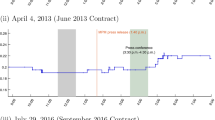Abstract.
Many researchers use GARCH models to generate volatility forecasts. Using data on three major U.S. dollar exchange rates we show that such forecasts are too high in volatile periods. We argue that this is due to the high persistence of shocks in GARCH forecasts. To obtain more flexibility regarding volatility persistence, this paper generalizes the GARCH model by distinguishing two regimes with different volatility levels; GARCH effects are allowed within each regime. The resulting Markov regime-switching GARCH model improves on existing variants, for instance by making multi-period-ahead volatility forecasting a convenient recursive procedure. The empirical analysis demonstrates that the model resolves the problem with the high single-regime GARCH forecasts and that it yields significantly better out-of-sample volatility forecasts.
Similar content being viewed by others
Author information
Authors and Affiliations
Additional information
First Version Received: November 2000/Final Version Received: August 2001
Rights and permissions
About this article
Cite this article
Klaassen, F. Improving GARCH volatility forecasts with regime-switching GARCH. Empirical Economics 27, 363–394 (2002). https://doi.org/10.1007/s001810100100
Issue Date:
DOI: https://doi.org/10.1007/s001810100100




